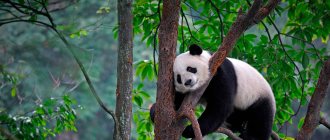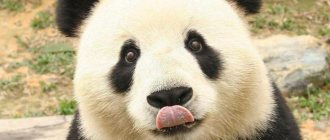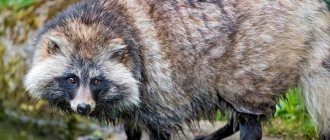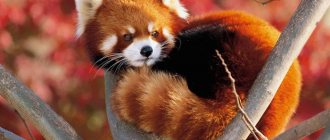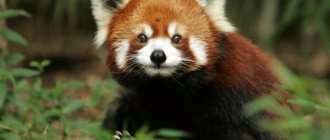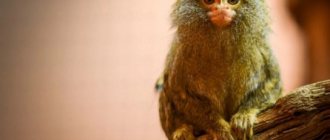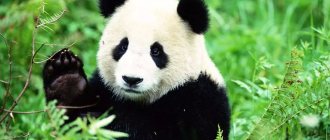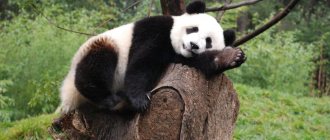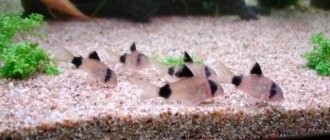Description, size, life expectancy
The red panda is a mammal from the order of carnivores. Many millions of years ago, the giant panda and the red panda had a common ancestor, but these animals, despite their similar name, have only a distant resemblance.
For a long time, scientists did not know which family to assign the animal to. Outwardly, it resembles a bear and a raccoon, the color of its fur and fluffy tail are like that of a fox. Thanks to genetic studies, it has been established that the red panda forms a separate family, Ailuridae. In appearance, the animal resembles a large domestic cat; males are slightly larger than females in weight and size.
How does a red panda feel at home?
Keeping a red panda at home does not bring anything good for the animal. Even in high-level zoos, significant efforts have to be made to provide them with decent living conditions, but at home this is almost impossible. As a result, a red panda that becomes a pet almost always suffers from problems with the digestive system. Typically, improper feeding leads to intestinal diseases, which quickly lead to the death of the animal. Owners of red pandas mistake their pet's funny appearance for a sign of well-being, but this has nothing to do with reality.
At home, pandas invariably die.
It is extremely difficult to provide the red panda with decent conditions.
Key Features
Pandas spend the greatest amount of time throughout their lives being alone.
And this is not surprising, because these lazy, clumsy animals spend all their time doing nothing but eating and sleeping. Only during the mating season they look for a mate.
Each panda owns its own territory and does not allow others into it. However, due to their natural peacefulness, they rarely lay claim to what belongs to others.
They become more active early in the morning and late at night, and mostly sleep during the day.
They can live at a maximum temperature of 25 degrees, but lower is better. If the temperature is higher, they may die.
Interesting! Representatives of this species spend sixteen hours a day searching for and chewing food. The rest of the time, the animals sleep high in the trees.
Red panda on vacation
You can find out about other unusual animals here:
Who owns all the pandas?
Did you know that all the pandas in the world belong to China? This is officially a national treasure of the Celestial Empire. And, if you meet a panda on the territory of a reserve or zoo in another country, know: China simply rented out this animal!
Interesting materials:
What is a seedling in biology? What is Zary backgammon? What are greens? What is green basil? What is the oceanic crust? What is Zero article? What is the desired date of enrollment in kindergarten? What is liquid chicory? What is dehydrated milk fat? What is Ziplac?
Gastronomic preferences
Like its larger “brothers,” the red panda feeds mainly on bamboo, the daily requirement of which is about four kilograms. This is due to the structure of the animal’s gastrointestinal tract, which is simply not capable of digesting anything else. Unlike large pandas, small pandas eat exclusively the most delicious things, namely tender shoots. In winter, the panda is forced to diversify its diet with berries, bird eggs and mushrooms. In rare exceptions, the panda attacks small rodents.
Habitat
The habitat is limited between the villages of Yunnan, Sichuan in China, and northern Burma, Bhutan, Nepal and northeast India. It will not be possible to meet this animal further west than Nepal.
They prefer to live in the highlands, from 1800 to 4800 thousand meters above water level, in a temperate climate, with an average temperature that is not subject to sudden changes.
These animals are covered with thick fluffy fur, therefore, like red wolves , they feel very uncomfortable in hot temperatures. The suitable air temperature for them is from 17 to 25°C.
If the temperature is higher, it is very dangerous for the health of animals. It is important that the habitat has enough deciduous and coniferous trees, bamboo and rhododendron.
This animal is peaceful and benevolent, and it has no enemies, but when it feels danger, it can run away to hide in a hollow tree, in rocks or on high branches.
The remains of the ancestors of these animals were found over larger territories, but their modern representatives are quite picky about the climate, so their range has decreased significantly.
The red panda spends most of the day in the trees
What do red pandas eat?
Although the red panda is a member of the order of carnivores, 95% of its diet consists of young leaves and shoots of bamboo. The remaining 5% are various fruits, berries, mushrooms, bird eggs and even small rodents.
Interesting materials:
What is a cow book? What is Hce and SIM wallet? What is the recipient's checkpoint? What is scope magnification? What is the Kremlin and the surrounding world? What is a crossover in an audio system? What is the culture of communication in the family? What is speech culture and what are its components? What is Quality example? What is Lemma?
Reproduction and offspring, life expectancy
The mating season begins in the month of January . Conception and further development of the embryo in the womb occurs in an unusual way. Pandas have a period of duration between the moment of conception and the period of pregnancy, which is called diapause. Fifty days of development from the moment of conception are enough for the fetus to be ready for birth , but taking into account diapause, the baby can be born 120 or more days from the date of conception.
An indicator of the imminent onset of labor is that the female begins active nesting. She creates a secluded place in the hollows of trees from branches and leaves. Babies are born weighing no more than 100 grams , they are completely deaf and blind.
The cub's fur color can range from light hazel to gray. Babies are never fiery red at birth. One litter usually contains 1-2 babies; it rarely happens that four babies are born, but in this case, as a rule, only one remains alive.
Panda cubs develop and grow for quite a long time and constantly require the attention and care of their mother. After eighteen days from their birth, they open their eyes. At the age of three months, red pandas try solid food and choose to forage for food on their own. From three months onwards, as they grow older, the coat color gradually acquires a typical fiery beautiful color.
After the final completion of the period of growing up , the babies, together with their mother, leave their nest and explore the surroundings, wandering around.
At one and a half years the animal is already sexually mature, but a red panda is considered an adult at 3 years. Babies are born only once a year, which is why the increase in the population of these animals is so slow.
The lifespan of a small red animal in the wild is approximately ten years, in rare cases fifteen. In nurseries and zoos, the animal lives a little longer - about twelve years.
Characteristic
In many photos, the Chinese red panda looks like a very kind and sweet animal, but in nature they have to fight fiercely for existence.
Their main enemy in the wild is the snow leopard, from which they hide in trees or gorges.
Red pandas are classified as predators, however, they are quite peaceful and friendly animals; they can only hunt small rodents or steal eggs from birds' nests.
Other facts about animals that break stereotypes can be read here:
They have virtually no struggle for territory.
Males usually occupy much more space, a territory that is twice the size of that occupied by the female.
It is not entirely easy to tame them, but, as practice shows, they take root both in the wild and in artificially created habitats; the most important thing is to comply with all the requirements for habitat and nutrition, so as not to harm the health and life of these cute animals.
Important! This species is listed in the Red Book; hunting for them is prohibited. Special reserves are being created to preserve this species of little pandas.
In the wild, the Chinese red panda prefers to stay awake at night during its life. During the day they sleep in a hollow or on tree branches.
When they see a threat, they climb high into the trees and camouflage themselves using their color.
Animals feel much more comfortable in trees than on flat surfaces, where they move unevenly, slowly and awkwardly.
Small red pandas have their own language, which is very similar to a bird whistle. They make short, quiet sounds that also resemble the chirping of birds.
Little pandas playing with pumpkins
Interesting! The red panda is depicted on the logo of the Mozilla firefox browser, and not a fox, as many people think.
Name and appearance
In China, the red panda is called the fire fox. This is due to the external characteristics of the animal: size, coat color, muzzle. Interestingly, the color of each panda's face is unique.
The animal grows to the size of a large cat, but due to its thick fur it appears much larger. The body length is about 120 cm, and the weight of an adult reaches 5-7 kg. On its paws, the red panda has slightly curved claws, which provide it with the ability to climb trees. There is an “extra” finger on the front paws, thanks to which the animal can hold bamboo branches.
